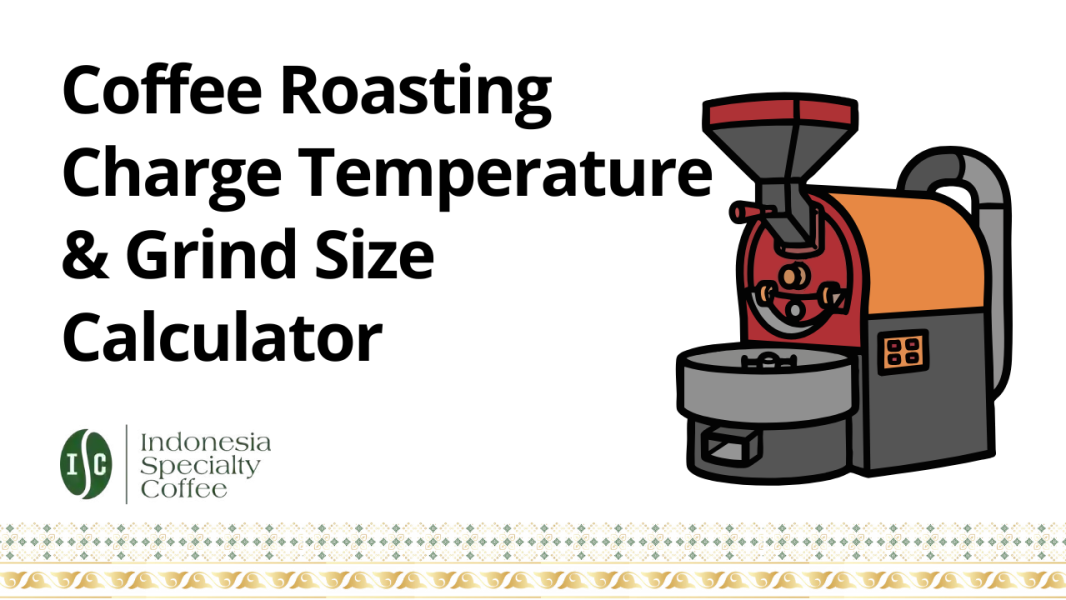Coffee Roasting Charge Temperature & Grind Size Calculator
Roasting coffee is a science of heat transfer, density, and timing—but getting the right charge temperature at the start makes all the difference. To simplify this process, we provide an interactive calculator that generates a recommended charge temperature range and grind size reference based on your green coffee’s characteristics.
Just enter the species of your coffee, its density, the measured moisture percentage, and your target roast level. The calculator will instantly show you the suggested charge temperature along with grind size recommendations for V60 pour over, French Press, Espresso, Moka Pot, and Cupping.
Coffee Roasting Calculator
How to Use the Calculator
The calculator is designed to turn complex roasting theory into a quick, actionable guide. Follow these steps to use it effectively:
- Select the coffee species. Choose Arabica, Robusta, Excelsa, or Liberica. This matters because each species has different density tendencies and heat absorption.
- Pick the density category. If you already know your bean density (measured in g/cm³), classify it as:
- High density (≥0.70 g/cm³) – common in high-altitude Arabica.
- Medium density (0.65–0.69 g/cm³) – balanced, often Arabica, Excelsa.
- Low density (≤0.64 g/cm³) – common in Robusta, Liberica.
- Enter the moisture percentage. Green coffee usually has 10–12% moisture. Enter your actual measurement if known; otherwise, use 11% as a safe default.
- Choose the roast level.
- Light
- Light to Medium
- Medium
- Medium to Dark
- Dark
- Read the results. The output will give you:
- A recommended charge temperature range in °C, adjusted for density, moisture, and species.
- A grind size reference for V60 pour over, French Press, Espresso, Moka Pot, and Cupping.
This workflow allows you to start with accurate roasting parameters and immediately connect them to brewing practices, ensuring consistency from roast to cup.
How to Measure Coffee Bean Density
To get accurate results from the calculator, you need to know whether your beans are low, medium, or high density. Fortunately, density can be measured with simple tools you likely already have.
Tools Needed
- Digital scale (precision to 0.1 g)
- Measuring cylinder or cup with a known volume (100 mL works best)
- Funnel (optional, for easy filling)
- Pen and paper
Step-by-Step Method
- Weigh the empty cylinder. Record the weight and tare the scale.
- Fill the cylinder with green beans up to exactly 100 mL. Do not shake or compress the beans.
- Weigh the full cylinder. Subtract the empty weight to get the mass of the beans.
- Calculate density using this formula: Density (g/cm³) = Mass of beans (g) ÷ Volume (cm³) Since 100 mL = 100 cm³, the number you get in grams directly equals the density value.
- Example: If 72 g of beans fit into 100 mL, density = 0.72 g/cm³.
- Repeat the measurement twice and take the average for better accuracy.
Quick Classification
- High Density (≥0.70 g/cm³): High-altitude Arabica.
- Medium Density (0.65–0.69 g/cm³): Balanced, common in Arabica and Excelsa.
- Low Density (≤0.64 g/cm³): Robusta, Liberica, or poorly processed beans.
Shortcuts
- Sink Test: Drop a few beans in water. High-density beans usually sink quickly.
- Water Displacement: Measure how much water is displaced when beans are added to a container. More precise, but less practical outside a lab.
Once you know your bean density, you can confidently use the calculator to set your charge temperature.
From Green Bean to Perfect Cup
Roasting is both science and craft. By combining three key variables, species, density, and moisture, you can start every roast with precision instead of guesswork. The calculator provides a fast way to set your charge temperature and align grind sizes across multiple brew methods, while density measurement gives you the foundation for accuracy.
Whether you work with high-density Arabica, Robusta, Excelsa, or Liberica, the principle is the same: know your beans, control your heat, and brew with intention. With the right starting point, consistency in both roasting and brewing becomes repeatable, leading to a more reliable and flavorful cup.
Get Indonesia Green Coffee Beans for your roasting needs from us!

